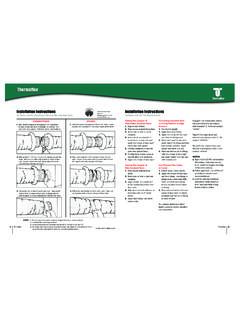Transcription of 1COUnting and MarKing - Samson Rope
1 PAGE 1 OF | Email | Tel + Class I Eye SpliceSAMSON SPLICING INSTRUCTIONS8-strand ropes, also known as plaited ropes, are composed of 8 strands grouped into 4 pairs. 2 of these pairs turn to the left (shown in gray), and 2 pairs turn to the right (shown in white.) Seen in this cross-section, the 4 strand pairs form the sides of a square. The strands that are on opposite sides of the square will rotate in the same RequiRed A splicing fid or marlinspike, sharp knife or scissors, plastic or masking tape , MarKing I ropes are made from any or all of the following fibers: olefin, polyester, or eye splice is used to place a permanent loop in the end of a rope, generally for attachment purposes to a fixed point. An eye is also used to form the rope around a thimble, which is used to protect the rope, especially when it is to be attached to a shackle, chain, or wire rope.
2 Bitter end of ropeStanding part of line10 picks1 Pickgetting startedCOUnting and MarKing1stepFrom the end of the rope, count a distance of 10 picks and apply tape securely around the rope immediately after the 10th pick, as shown in the illustration. This is Mark 1. Apply the tape securely enough so that it will not move during the splicing 1 From the end of the rope; mark the first 10-picks up to the tape at Mark 1. Continue MarKing the length of the eye and at least an additional 6 picks past Mark 2. Mark all strands that rotate left on both sides of the braided tHe eYe and MarKing tHe rOPeMarKing tHe LeFt-rOtating strandsForm the desired size of the eye being careful not to add twist to the rope. Mark the rope adjacent to the tape .
3 This is Mark 2 Mark 1 Mark 2 Mark 1 Mark 2 Mark 1 Note: The strands that rotate left (gray) can be marked for improved visual reference. 8-strand ropes are composed of 4 pairs of 2 strands each. 2 of the strand pairs rotate to the left, and 2 pairs rotate to the right. When MarKing the left-rotating strands, be sure to turn the rope over and mark the left-rotating strands on the opposite side of the rope overPAGE 2 OF | Email | Tel + Class I Eye SpliceSAMSON SPLICING INSTRUCTIONSMark 14steptaPing tHe ends and UnLaYing tHe rOPe4a4B4 CTape the ends of each of the 8 strands the strand pairs all the way back to the tape at Mark 1. Keep the pairs of strands together while unlayed, the strands in a pair will be twisted around each other.
4 Untwist each strand pair so the 2 strands lie parallel to each other, rather than twisting around each other. tape the ends of each pair together. 4a4B4 CIndividually taped endsArrange the strand pairs as shown in Fig. A. One set of the marked (gray) strands is on the top; and the other marked (gray) strands are on the bottom. The unmarked (white) pair will be on the left and right. 5stepMark 2 Mark 1 POsitiOning tHe strandsFigure aFOrMing tHe eYerOUte tUCKing tHe strand Pairs6step7a7 BPhysically form the eye, making certain there is no twist in the rope. Place the (white) pair that is closest to the standing part of the rope over the rope, at Mark 2, as shown in Fig. B; being careful not to add twist to the with the left rotating marked (gray) pair of strands on top, make your first tuck under the right rotating (white) pair of strands closest to Mark 2.
5 Pull the strands completely through, making sure that the strands don t twist (Fig. C).Turn the eye over and tuck the other marked (gray) pair of strands under the (white) pair of strands directly opposite the previous tuck (Fig. D). 7stepNote: If necessary, use a fid or marlinspike to loosen the strands. The left rotating (gray) strands will be tucked under the right rotating (white) strands, and vice 2 Mark 1 Mark 2 Mark 1 Mark 1 Figure BFigure CFigure dTurn rope overPAGE 3 OF | Email | Tel + Class I Eye SpliceSAMSON SPLICING INSTRUCTIONS7C7D7 ETuck the (white) pair of strands under the (gray) pair of strands closest to the first 2 tucks. Pull the strands snug, but not tight to avoid distorting the strands in the eye area.
6 Again, make sure there is no twist in the strands (Fig. E).Turn the eye over and tuck the remaining (white) pair of strands under the remaining (gray) pair of strands in the standing part of the rope (Fig. F). Remove tape and pull all 8 strands snug and correct any twist that may have been introduced during the tucking procedure. The first tuck is now complete (Fig. G).Note: A full tuck includes all 4 pairs of 1 Mark 2 Mark 1 Turn rope overFigure eFigure FFigure g1 complete tuckMark 2 Note: The 8 ends can be heat fused so they don t fray, but be careful not to damage any of the strands. 8B8C8D8 EAfter each round of tucks, pull each strand to make sure they are snug and there is no twist. The splice should look like Fig.
7 The strand closest to the eye in each strand pair. tape and cut off, leaving enough of the end protruding so it does not slip back into the rope when loaded. The splice should look like Fig. tucking the remaining strands, with the (gray) strands under the (white) strands, and vice versa, for 2 more full and cut off the remaining strands. The finished splice should look like Fig. tucking the (gray) strands under the (white) strands and the (white) strands under the (gray) strands until at least 4 full tucks (with all 4 strand pairs) have been completed. 8stepCOMPL eting tHe tUCKs and FinisHing tHe sPLiCeFigure HFigure iFigure JFinished spliceDOCUMENT 8 Strand_C1_Eye 2012 Samson Rope Technologies, Inc. All rights reserved.
8 S/WD #108294 7/2012





